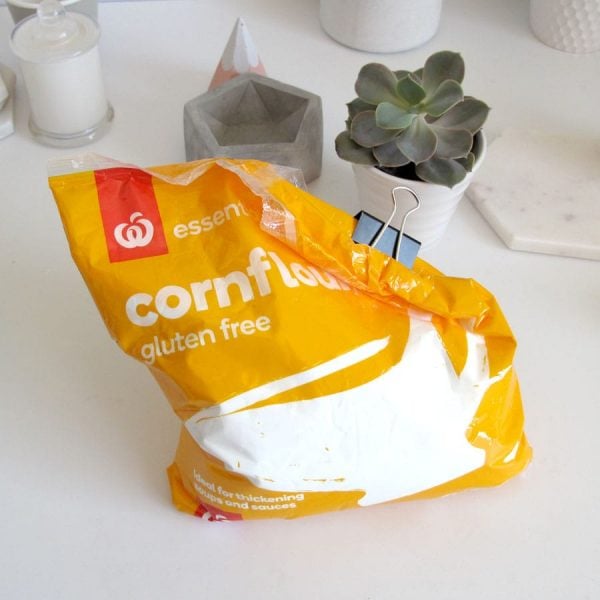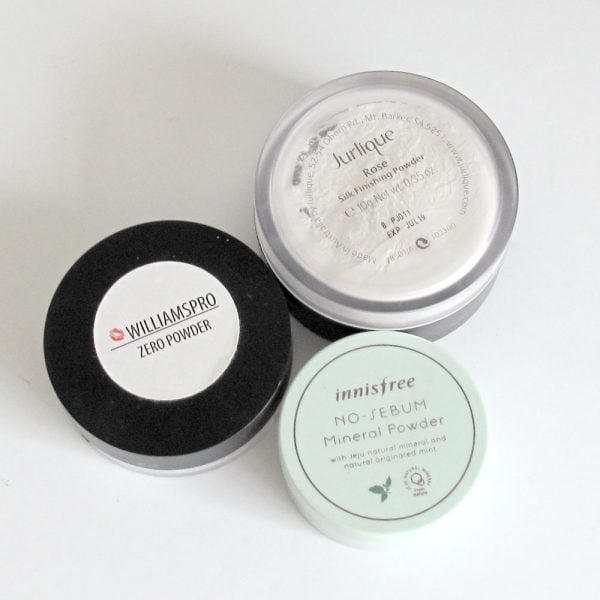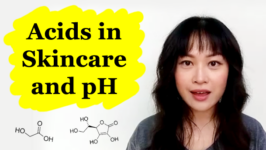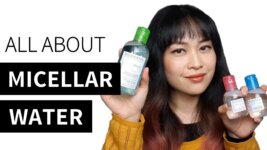The latest high-impact addition to my make-up stash has been a $2 sack of corn starch. No, I haven’t turned into a “if you can’t eat it, don’t put it on your face” woo-meister… here’s the lowdown.
Why Am I Putting Corn Starch on My Face?
I am an oily beast. My skin is generally hydrated and non-irritated, so it’s not my skin overproducing oil – it’s just naturally oily.
This means I tend not to wear moisturiser during the day, and even them my make-up will generally slide around and bunch up during the day. There are a few things I’ve found really handy for dealing with it, and one of the most effective things has been using a starch-based face powder.
I’ve tried a lot of different translucent powders to try to soak up oil, but the one that have worked best for me so far have been Williamspro Zero Powder, Jurlique Rose Silk Finishing Powder and Innisfree No Sebum Mineral Powder. Their top 3 ingredients:
- Williamspro Zero Powder: Certified Organic Arrowroot Powder, Australian Green Clay, Australian White Clay
- Jurlique Rose Silk Finishing Powder: Zea mays (Corn) Starch, Oryza sativa (Rice) Starch, Silica
- Innisfree No Sebum Mineral Powder (now slightly reformulated and called Matte Mineral Setting Powder): Silica, Corn Starch Modified, Dimethicone/Vinyl Dimethicone Crosspolymer
So you can see – the top ingredients all include some form of starch.
There’s also been a trend of people using talcum powder on their face, so I unearthed this from Amazon:
Johnson’s Pure Cornstarch Baby Powder With Aloe Vera & Vitamin E
Ingredients: Zea Mays (Corn) Starch, Tricalcium Phosphate, Aloe Barbadensis, Tocopheryl Acetate (Vitamin E), Fragrance
Note: no preservative. So why not try corn starch from the grocery aisle?
Issues with Corn Starch as Face Powder and Solutions
These are the most common objections to using food-grade corn starch as face powder that I’ve come across:
Corn starch can grow bacteria/fungus while in the container
This is probably the most common one: corn starch is food, and can breed fungus and bacteria while in the container. If you put that on your face, it can give you breakouts.
But as mentioned, Johnson’s Baby Powder has no preservative, and it’s sold commercially. Generally, super dry, dehydrating materials like starch are naturally anti-microbial if they stay dry – they’ll suck the moisture out of microorganisms and stop them from breeding, like a lot of other dried food items (rice, flour, pasta). However, it’s sold in a shaker bottle and doesn’t get dirty make-up brushes dipped into it repeatedly.
The safest thing to do is to replicate this – I use a sifter container and shake the corn starch into the lid and swirl my brush into that.
Corn starch can grow bacteria/fungus while on your face
But what about on your face, when the corn starch soaks up water and oil during the day? Can’t that help bacteria and fungus, especially when there’s naturally loads of bacteria and fungus on your face?
This one was new to me and properly freaked me out for a few minutes. But again, corn starch without preservative is sold as talcum powder for babies’ bottoms, which is much damper and grosser than your face. There’s actually been a study on corn starch powder under occlusive bandages that trap heat and moisture (they were meant to simulate plastic nappies). Even under these bacteria and yeast friendly conditions, it didn’t make a big difference compared to no corn starch, and there wasn’t a difference between cosmetic-grade corn starch and storebought corn starch.
Corn starch can cause allergic reactions
This is true, but it’s true for any “natural” product. Test it, and if you’re allergic don’t use it. “GMO-free” won’t make something less allergenic.
Corn starch from the grocery store is too clumpy to work well
I personally didn’t find this to be the case with the corn starch I used, and part of the reason it worked well is probably because of the sifter. I don’t think there isn’t really a way around this except for trial and error with different starch products.
How well does corn starch face powder work?
On my skin: amazingly well. It’s been the best powder I’ve ever tried for keeping oil at bay, and obviously it’s super budget friendly. I’m yet to try a different type of flour, but I’ve heard that rice and arrowroot flour work well too.
The biggest issue I’ve run into is that corn starch is a bit of a pain to get out of the sifter – I have to whack it out pretty firmly multiple times to get enough for one application, while properly formulated starch-based powders just need a gentle shake.
The other issue is that it can work a bit too well, and end up drying out your skin. When I started using tretinoin (more on that later) my skin got drier and flakier, and plain corn starch made my face flaky in the middle of the day. My sister who’s on spironolactone and has slightly drier skin also had this issue (yes, I make her test things for me). If you have dry skin you’ll only be able to handle a very light dusting.
One thing that works well for both of these is to mix the corn starch into another face powder until you have the right level of oil control. I’ve been amping up Jurlique Rose Silk Finishing Powder this way, plus it makes it last a bit longer.
I also found that it was a bit more whitening than most face powders I’ve come across. If your skin is darker this might not work as well for you.
I’ve also found that corn starch also works fantastically well as dry shampoo! My favourite dry shampoo (Batiste) uses rice starch as the main ingredient.
References
Leyden JJ, Corn starch, Candida albicans, and diaper rash, Pediatr Dermatol 1984, 1, 322-325.
This post contains affiliate links – if you decide to click through and support Lab Muffin financially (at no extra cost to you), thank you! For more information, see Disclosure Policy.








Now that is interesting, I need to see if that works for me. My skin gets really oils throughout the day, especially on my t-zone, and so far no powder has been able to solve that issue.
Let me know how it goes if you decide to try it!
Thank you for sharing detailed information about a cost effective solution! I wanted to add to this topic: my daughter has sensitive, dry acne prone skin. She discovered that colloidal oat powder works best as a face powder and dry shampoo. It is not as drying as the starches and so does not dry out her skin or irritate her scalp. The fine oat powder seems to have some hydrating properties that have reduced dryness! Just wanted to share another inexpensive solution!!
That sounds fantastic! Oats are amazing.
Oooo this is a fascinating post, Michelle! Thanks for going in to the common objections against using corn starch. I’m also an oily beast so I welcome anything that can help keep that under control. Have you tried baking (as in setting undereye concealer, not actual baking haha) with it?
I haven’t tried baking but I don’t really wear undereye concealer because it always creases on me 🙁
I just wrote a comment but I think the comment form ate it… Oh well just in case – I was wondering, have you tried baking (the setting concealer kind, not the cooking kind) with cornstarch?
You know why I have been reading your blog for years? And why I keep coming back? Your excellently researched, interesting educated posts.
It’s another reason I follow you on Insta ?
Hahaha thank you so much! 😀
I’m really hating my IT cosmetic face powder, ran out of my favorite Clinique, so tried this cornstarch yesterday. I sifted a teaspoon through a tiny fine kitchen mesh strainer, then applied it with a powder brush. Wow! It set my foundation all day. Best of all, it smoothed out my large pores and didn’t settle into my fines. It gave me an incredibly nature look. Loved it.
Definitely will use cornstarch again.
Yay! I’m so glad it worked for you 😀
I’ve been using arrowroot powder as dry shampoo for years. It’s great, I just have to put it on the night before so it doesn’t look too powdery.
I put cornstarch in my hair in the morning and then frantically brush it out 😉
I never thought of using corn starch on my face. But yes I tried it on my hair when it becomes oily and I have no time to wash my hair. Thanks for sharing this tip with us:)
What a cool idea!
Since I’m allergic to most sunscreen-ingredients the one that I use makes my face look very greacy. this is why I apply cornstarch over my face after applying sunscreen.
Could applying cornstarch over my sunscreen weaken the protection of the sunscreen? I’ve read somewhere that applying powder over sunscreen actually decreases the protection.
Applying anything over sunscreen will decrease the protection, but it’s all about making the least compromises – just like how a fully white face will give the best sun protection, for practicality’s sake sometimes lower protection has to happen.
Burmese people like to put tons of thanaka powder on their face – another alternative to consider.
Thank you for demystifying this. I am trying to avoid all the plastic pots associated with make up and wanted to try something I could buy in less packaging, but was put off by all the scaremongering. Well done.
Once winter rolls around here again in the states (I get more oil in winter when it’s dryer and sebum over produces to protect), I’ll have to try this! I’m all about utilizing science as best as possible for our bodies, while not just succumbing to anecdotal evidence – loved that recent post too, btw. With that, here’s some half anecdotal, half tested evidence….lol
RE: using starches/powders in your hair-
If you’re using powders frequently, be sure to wash you’re hair prior to color services. As the powders build up a bit, they can inhibit color from penetrating the cuticle fully. Really this is true of anything building up on the hair shaft, even your own sebum! For years we told clients to come in with dirty hair for color treatments, but color has so much less ammonia now that it did before, that protective barrier is not only no longer required, but counter-productive.
I’ve even heard theories that the residual powders can absorb enough of just the color portion or the developer portion of your formula to cause uneven and unpredictable oxidation in addition to having an added layer to work through before reaching the cuticle.
Best powder practices – put in at night and brush out in the morning for best absorption, plus least damage to the cuticle itself. Most of us need to brush our hair in the morning anyways to calm bedhead, so why put your hair through that twice? Wash hair and put as little in it as possible between 5-10 hrs prior to coloring services.
– your friendly, nerdy cosmetologist